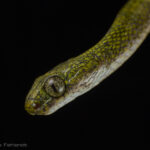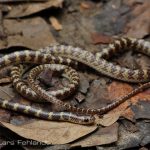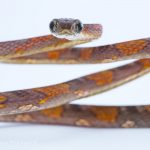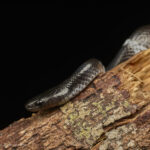White-spotted cat snake, Boiga drapiezii (H. Boie in F. Boie, 1827) – of West-Sarawak/Borneo – around 1250m ASL
Boiga drapiezii (white-spotted cat snake) is a slender, arboreal, rear-fanged colubrid distributed across maritime Southeast Asia, including Indonesia (Java, Sumatra, Borneo, Mentawai and Natuna islands), Brunei, Malaysia (Peninsular and Bornean states), the Philippines (e.g., Luzon and the Sulu Archipelago), Singapore, Myanmar, Thailand, and Vietnam, occurring from lowland rainforest up to roughly 1,200m in primary, secondary, and swamp forests. An opportunistic predator, it feeds on large insects, frogs, and arboreal lizards such as Draco, as well as birds and their eggs. The species is oviparous; typical clutches contain about 4–10 eggs, and egg-laying has been documented in arboreal termite nests or termite-infested wood. Adults may reach ~210 cm total length and show marked color polymorphism (commonly reddish-brown or gray-green with pale spotting). Like many Boiga, it is opisthoglyphous with venom considered mild for humans, with no well-documented medically significant effects. It is currently assessed as Least Concern and was described by F. Boie in 1827; the specific epithet honors Auguste Drapiez.





